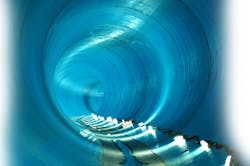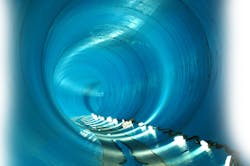Singapore to integrate water reuse/solid waste treatment in tender flurry
SINGAPORE- Singapore’s national water agency PUB and the National Environment Agency of Singapore (NEA) will shortly be calling tenders for the Deep Tunnel Sewerage System (DTSS) Phase 2 and the Integrated Waste Management Facility (IWMF).
DTSS Phase 2, which includes enhanced deep tunnels with advanced sensing and maintenance features, associated link sewers, Tuas Water Reclamation Plant (TWRP) and integrated NEWater factory, is estimated to cost some S$6.5 billion.
With a total treatment capacity of 800,000 m3/day, TWRP will also be the largest membrane bioreactor (MBR) facility in the world, according to PUB.
Currently at the detailed design milestone of the project, PUB will be calling for consultancy and construction tenders for the various project components in phases beginning from Q3 2016.
These include professional engineering services for the detailed design of the TWRP and link sewers.
Other tenders will cover the design and construction of deep tunnel sewers, associated shafts and manholes.
Earlier this year PUB called a pre-qualification exercise for consultancy firms to design the Tuas water reclamation plant (read WWi story).
IWMF will be able to effectively process various waste streams which include incinerable waste, household recyclables collected under the National Recycling Programme (NRP), source-segregated food waste and dewatered sludge from the TWRP.
The IWMF will be designed with an incineration capacity of 5,800 tonnes per day and is estimated to cost S$3.0 billion.
NEA will be calling tender to engage professional engineering services to assist in project management, supervision of the construction works and commissioning of the IWMF.
Tenders will also be called to appoint Engineering, Procurement and Construction contractors to design and construct the IWMF.
One of the highlights of both projects, is the co-location the water reclamation plant with the waste management facility, which marks Singapore’s first initiative to integrate used water and solid waste treatment processes.
“As one of the world's most anticipated water infrastructure projects, DTSS Phase 2 continues to harness advanced technologies to enhance Singapore’s used water management system and ensure its water sustainability for generations to come,” said Yong Wei Hin, director, DTSS Phase 2, PUB.
“The co-location of TWRP and IWMF is also the first project of its kind in the world to be planned from ground-up, and is designed to bring about a multitude of synergies harnessing the Water-Energy-Waste Nexus while optimising Singapore’s land-use”.
PUB said a good example of the synergies is the co-digestion of food waste with used water sludge at TWRP to increase the yield of biogas production. Biogas will be utilised at IWMF to improve steam quality and give rise to higher overall plant thermal efficiency. This will increase electricity production and enable IWMF to export more to the Grid while allowing both facilities to be energy self-sufficient.
“The co-location of the TWRP and IWMF marks a new chapter in the way used water and solid waste are managed in land-scarce Singapore. Leveraging the use of advanced technologies and project innovations, the two facilities will be able to maximise energy and resource recovery efficiencies while minimising their environmental and land footprint,” said Joseph Boey, project director, IWMF, NEA.
###
Read/Watch more
VIDEO: DTSS2: Singapore’s next deep tunnel
Singapore plans for 55% water recycling with DTSS pre-qualification

